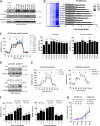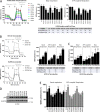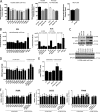Effect of Mutant p53 Proteins on Glycolysis and Mitochondrial Metabolism
- PMID: 28993478
- PMCID: PMC5705820
- DOI: 10.1128/MCB.00328-17
Effect of Mutant p53 Proteins on Glycolysis and Mitochondrial Metabolism
Abstract
TP53 is one of the most commonly mutated genes in human cancers. Unlike other tumor suppressors that are frequently deleted or acquire loss-of-function mutations, the majority of TP53 mutations in tumors are missense substitutions, which lead to the expression of full-length mutant proteins that accumulate in cancer cells and may confer unique gain-of-function (GOF) activities to promote tumorigenic events. Recently, mutant p53 proteins have been shown to mediate metabolic changes as a novel GOF to promote tumor development. There is a strong rationale that the GOF activities, including alterations in cellular metabolism, might vary between the different p53 mutants. Accordingly, the effect of different mutant p53 proteins on cancer cell metabolism is largely unknown. In this study, we have metabolically profiled several individual frequently occurring p53 mutants in cancers, focusing on glycolytic and mitochondrial oxidative phosphorylation pathways. Our investigation highlights the diversity of different p53 mutants in terms of their effect on metabolism, which might provide a foundation for the development of more effective targeted pharmacological approaches toward variants of mutant p53.
Keywords: EMT; OxPhos; cancer; glycolysis; metabolism; mutant p53.
Copyright © 2017 American Society for Microbiology.
Figures






Similar articles
-
Tumor suppressor p53 and its mutants in cancer metabolism.Cancer Lett. 2015 Jan 28;356(2 Pt A):197-203. doi: 10.1016/j.canlet.2013.12.025. Epub 2013 Dec 24. Cancer Lett. 2015. PMID: 24374014 Free PMC article. Review.
-
Tumor suppressor p53 and metabolism.J Mol Cell Biol. 2019 Apr 1;11(4):284-292. doi: 10.1093/jmcb/mjy070. J Mol Cell Biol. 2019. PMID: 30500901 Free PMC article. Review.
-
Mutant p53R248Q downregulates oxidative phosphorylation and upregulates glycolysis under normoxia and hypoxia in human cervix cancer cells.J Cell Physiol. 2019 May;234(5):5524-5536. doi: 10.1002/jcp.27354. Epub 2018 Sep 10. J Cell Physiol. 2019. PMID: 30272821
-
Wild type- and mutant p53 proteins in mitochondrial dysfunction: emerging insights in cancer disease.Semin Cell Dev Biol. 2020 Feb;98:105-117. doi: 10.1016/j.semcdb.2019.05.011. Epub 2019 May 23. Semin Cell Dev Biol. 2020. PMID: 31112799 Review.
-
Mutant p53 partners in crime.Cell Death Differ. 2018 Jan;25(1):161-168. doi: 10.1038/cdd.2017.185. Epub 2017 Nov 3. Cell Death Differ. 2018. PMID: 29099488 Free PMC article. Review.
Cited by
-
m1A methylation modification patterns and metabolic characteristics in hepatocellular carcinoma.BMC Gastroenterol. 2022 Mar 3;22(1):93. doi: 10.1186/s12876-022-02160-w. BMC Gastroenterol. 2022. PMID: 35240991 Free PMC article.
-
Effects of Dose Rate on the Reproductive Cell Death and Early Mitochondrial Membrane Potential in Different Human Epithelium-Derived Cells Exposed to Gamma Rays.Dose Response. 2019 May 30;17(2):1559325819852508. doi: 10.1177/1559325819852508. eCollection 2019 Apr-Jun. Dose Response. 2019. PMID: 31210757 Free PMC article.
-
Targetome analysis of chaperone-mediated autophagy in cancer cells.Autophagy. 2019 Sep;15(9):1558-1571. doi: 10.1080/15548627.2019.1586255. Epub 2019 Mar 20. Autophagy. 2019. PMID: 30821613 Free PMC article.
-
Glycolytic competence in gastric adenocarcinomas negatively impacts survival outcomes of patients treated with salvage paclitaxel-ramucirumab.Gastric Cancer. 2020 Nov;23(6):1064-1074. doi: 10.1007/s10120-020-01078-0. Epub 2020 May 5. Gastric Cancer. 2020. PMID: 32372141 Free PMC article.
-
ING2 Controls Mitochondrial Respiration via Modulating MRPL12 Ubiquitination in Renal Tubular Epithelial Cells.Front Cell Dev Biol. 2021 Aug 9;9:700195. doi: 10.3389/fcell.2021.700195. eCollection 2021. Front Cell Dev Biol. 2021. PMID: 34434929 Free PMC article.
References
-
- Jacks T, Remington L, Williams BO, Schmitt EM, Halachmi S, Bronson RT, Weinberg RA. 1994. Tumor spectrum analysis in p53-mutant mice. Curr Biol 4:1–7. - PubMed
-
- Muller PA, Caswell PT, Doyle B, Iwanicki MP, Tan EH, Karim S, Lukashchuk N, Gillespie DA, Ludwig RL, Gosselin P, Cromer A, Brugge JS, Sansom OJ, Norman JC, Vousden KH. 2009. Mutant p53 drives invasion by promoting integrin recycling. Cell 139:1327–1341. doi:10.1016/j.cell.2009.11.026. - DOI - PubMed
MeSH terms
Substances
LinkOut - more resources
Full Text Sources
Other Literature Sources
Research Materials
Miscellaneous
